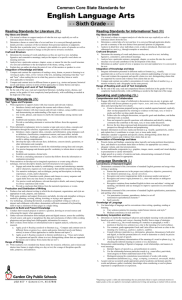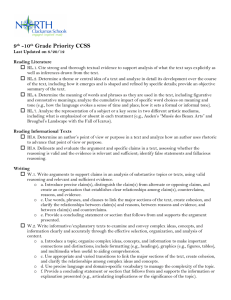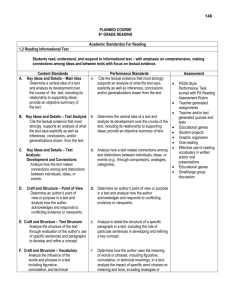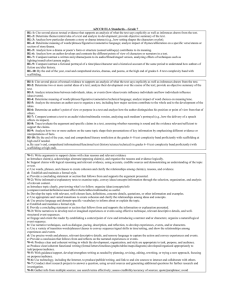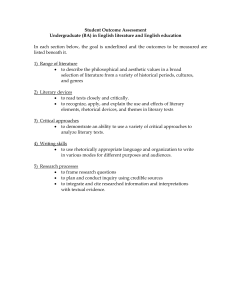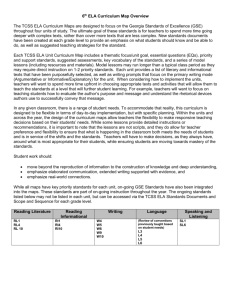I Can Statements Sixth Grade English Language Arts Standards
advertisement
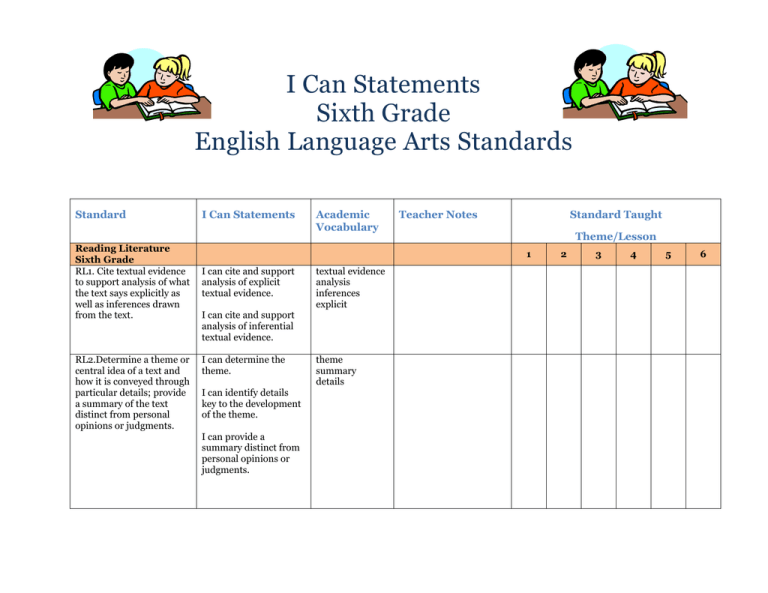
I Can Statements Sixth Grade English Language Arts Standards Standard Reading Literature Sixth Grade RL1. Cite textual evidence to support analysis of what the text says explicitly as well as inferences drawn from the text. RL2.Determine a theme or central idea of a text and how it is conveyed through particular details; provide a summary of the text distinct from personal opinions or judgments. I Can Statements Academic Vocabulary Teacher Notes Standard Taught Theme/Lesson 1 I can cite and support analysis of explicit textual evidence. textual evidence analysis inferences explicit I can cite and support analysis of inferential textual evidence. I can determine the theme. I can identify details key to the development of the theme. I can provide a summary distinct from personal opinions or judgments. theme summary details 2 3 4 5 6 RL3. Describe how a particular story’s or drama’s plot unfolds in a series of episodes as well as how the characters respond or change as the plot moves toward a resolution. I can describe how a story’s plot unfolds in a series of episodes. RL4. Determine the meaning of words and phrases as they are used in a text, including figurative and connotative meanings; analyze the impact of a specific word choice on meaning and tone. I can determine the literal, figurative, and connotative meaning of words and phrases in the texts. RL5. Analyze how a particular sentence, chapter, scene, or stanza fits into the overall structure of a text and contributes to the development of the theme, setting, or plot. I can analyze how sentences, chapters, scenes, or stanzas fit the structure of a text. RL6. Explain how an author develops the point of view of the narrator or speaker in a text. I can explain how an author develops the point of view of the narrator or speaker in a text. plot characters resolution I can describe how characters respond or change as the plot moves toward a resolution. I can analyze the impact of specific word choice on meaning and tone. I can analyze how sentences, chapters, scenes, or stanzas contribute to the development of themes, setting, or plot. literal figurative connotative word choice tone meaning sentence chapter scene stanza theme setting plot point of view narrator 1 2 3 4 5 6 RL7. Compare and contrast the experience of reading a story, drama, or poem to listening to or viewing an audio, video, or live version of the text, including contrasting what they “see” and “hear” when reading the text to what they perceive when they listen or watch. I can compare reading a story, drama, or poem with listening to, or viewing an audio, video, or live version of the text. compare contrast I can contrast reading with other modes of presentation. RL 8(Not applicable to literature) RL9. Compare and contrast texts in different forms or genres (e.g., stories and poems; historical novels and fantasy stories) in terms of their approaches to similar themes and topics. I can compare different genres in approaches in similar themes and topics. RL10. By the end of the year, read and comprehend literature, including stories, dramas, and poems, in the grades 6–8 text complexity band proficiently, with scaffolding as needed at the high end of the range. I can proficiently read literature in the 6-8 text band with scaffolding at the high end of the range. I can contrast different genres in approaches in similar themes and topics. I can comprehend literature in the 6-8 text band with scaffolding at the high end of the range. compare contrast genre scene topic scaffolding 1 2 3 4 5 6 Reading Informational Text - Sixth Grade RI1. Cite textual evidence to support analysis of what the text says explicitly as well as inferences drawn from the text. RI2. Determine a central idea of a text and how it is conveyed through particular details; provide a summary of the text distinct from personal opinions or judgments. 1 I can cite and support analysis of explicit textual evidence. I can cite and support analysis of inferential textual evidence. I can determine the central idea. I can identify details key to the development of the central idea. textual evidence analysis inferences explicitly central idea summary details I can provide a summary distinct from personal opinions or judgments. RI3. Analyze in detail how a key individual, event, or idea is introduced, illustrated, and elaborated in a text (e.g., through examples or anecdotes). I can analyze how an individual, event, or idea is introduced in the text. I can analyze how an individual, event, or idea is illustrated in the text. I can analyze how an individual, event, or idea is elaborated in the text. analyze introduced illustrated elaborated 2 3 4 5 6 RI4. Determine the meaning of words and phrases as they are used in a text, including figurative, connotative, and technical meanings. I can determine the literal, figurative, and connotative and technical meaning of words. RI5. Analyze how a particular sentence, paragraph, chapter, or section fits into the overall structure of a text and contributes to the development of the ideas. I can analyze how sentences, paragraphs, chapters, or sections fit the structure of a text. RI6. Determine an author’s point of view or purpose in a text and explain how it is conveyed in the text. I can determine an author's point of view or purpose. RI7. Integrate information presented in different media or formats (e.g., visually, quantitatively) as well as in words to develop a coherent understanding of a topic or issue I can integrate information from different formats to develop an understanding of a topic or issue. I can analyze the impact of specific word choice on meaning and tone. literal figurative connotative word choice tone meaning sentences paragraphs chapter sections ideas I can analyze how sentences, paragraphs, chapters, or sections contribute to the development of ideas. point of view purpose I can determine how an author's point of view or purpose is conveyed in the text. integrate 1 2 3 4 5 6 RI8. Trace and evaluate the argument and specific claims in a text, distinguishing claims that are supported by reasons and evidence from claims that are not. I can trace the argument and specific claims in a text. trace evaluate claims argument I can evaluate the argument and specific claims in a text. I can distinguish claims that are supported by reasons and evidence from claims that are not. RI9. Compare and contrast one author’s presentation of events with that of (e.g., a memoir written by and a biography on the same person). I can compare one author’s presentation of events with that of another. RI10. By the end of the year, read and comprehend literary nonfiction in the grades 6– 8 text complexity band proficiently, with scaffolding as needed at the high end of the range. I can read literary nonfiction in the 6-8 text band with scaffolding at the high end of the range. compare contrast I can contrast one author’s presentation of events with that of another. I can comprehend literary non-fiction in the 6-8 text band with scaffolding at the high end of the range. scaffolding 1 2 3 4 5 6 Writing – Sixth Grade 1 W 1. Write arguments to support claims with clear reasons and relevant evidence. I can write arguments to support claims with clear reasons and relevant evidence. arguments clear reasons relevant evidence a. Introduce claim(s) and organize the reasons and evidence clearly. I can introduce claim(s). claims reasons evidence b. Support claim(s) with clear reasons and relevant evidence, using credible sources and demonstrating an understanding of the topic or text. I can support claim(s) with clear reasons and relevant evidence. I can organize reasons and evidence clearly. I can use credible sources. claims reasons evidence credible sources I can demonstrate an understanding of the topic or text. c. Use words, phrases, and clauses to clarify the relationships among claim(s) and reasons. I can use words, phrases, and clauses to clarify the relationships among claim(s) and reasons. clarify d. Establish and maintain a formal style. I can establish and maintain a formal style. formal style e. Provide a concluding statement or section that follows from the argument presented. I can provide a concluding statement or section that follows from the argument presented. concluding statement 2 3 4 5 6 W 2. Write informative/explanatory texts to examine a topic and convey ideas, concepts, and information through the selection, organization, and analysis of relevant content. I can write informative/explanator y texts to examine a topic and convey ideas, concepts, and information. informative/ explanatory texts a. Introduce a topic; organize ideas, concepts, and information, using strategies such as definition, classification, comparison/contrast, and cause/effect; include formatting (e.g., headings), graphics (e.g., charts, tables), and multimedia when useful to aiding comprehension. I can introduce a topic; organize ideas, concepts, and information. b. Develop the topic with relevant facts, definitions, concrete details, quotations, or other information and examples. I can develop the topic with relevant facts, definitions, concrete details, quotations, or other information and examples. relevant facts definitions concrete details quotations c. Use appropriate transitions to clarify the relationships among ideas and concepts. I can use appropriate transitions to clarify the relationships among ideas and concepts. transitions clarify relationships I can select, organize and analyze relevant content. I can use strategies such as definition, classification, comparison/contrast, and cause/effect. definition classification comparison/ contrast cause/effect formatting graphics multimedia I can include formatting, graphics, and multimedia when useful to comprehension. 1 2 3 4 5 6 d. Use precise language and domain-specific vocabulary to inform about or explain the topic. I can use precise language and domainspecific vocabulary to inform about or explain the topic. precise language domain-specific e. Establish and maintain a formal style. I can establish and maintain a formal style. f. Provide a concluding statement or section that follows from the information or explanation presented. I can provide a concluding statement or section that follows from the information or explanation presented. establish maintain formal style concluding statement W 3. Write narratives to develop real or imagined experiences or events using effective technique, relevant descriptive details, and wellstructured event sequences. I can write narratives to develop real or imagined experiences or events. a. Engage and orient the reader by establishing a context and introducing a narrator and/or characters; organize an event sequence that unfolds naturally and logically. I can engage and orient the reader by establishing a context and introducing a narrator and/or characters. I can use effective technique, relevant descriptive details, and well-structured event sequences. I can organize an event sequence that unfolds naturally and logically. narratives effective technique relevant descriptive details well-structured event sequences engage orient context narrator character event sequence 1 2 3 4 5 6 b. Use narrative techniques, such as dialogue, pacing, and description, to develop experiences, events, and/or characters. I can use narrative techniques, such as dialogue, pacing, and description, to develop experiences, events, and/or characters. narrative techniques c. Use a variety of transition words, phrases, and clauses to convey sequence and signal shifts from one time frame or setting to another. I can use a variety of transition words, phrases, and clauses to convey sequence and signal shifts from one time frame or setting to another transition words sequence d. Use precise words and phrases, relevant descriptive details, and sensory language to convey experiences and events. I can use precise words and phrases, relevant descriptive details, and sensory language to convey experiences and events sensory language e. Provide a conclusion that follows from the narrated experiences or events. I can provide a conclusion that follows from the narrated experiences or events. conclusion WS 4. Produce clear and coherent writing in which the development, organization, and style are appropriate to task, purpose, and audience. (Grade-specific expectations for writing types are defined in standards 1–3 above.) I can produce clear and coherent writing in which the development, organization, and style are appropriate to task, purpose, and audience. 1 2 3 4 5 6 W 5. With some guidance and support from peers and adults, develop and strengthen writing as needed by planning, revising, editing, rewriting, or trying a new approach. (Editing for conventions should demonstrate command of Language standards 1–3 up to and including grade 6 on page 52.) I can, with some guidance and support from peers and adults, develop and strengthen writing as needed by planning, revising, editing, rewriting, or trying a new approach. W6. Use technology, including the Internet, to produce and publish writing as well as to interact and collaborate with others; demonstrate sufficient command of keyboarding skills to type a minimum of three pages in a single sitting. I can use technology, including the Internet, to produce and publish writing. W7. Conduct short research projects to answer a question, drawing on several sources and refocusing the inquiry when appropriate I can conduct short research projects to answer a question. 1 technology keyboarding I can interact and collaborate with others. I can demonstrate sufficient command of keyboarding skills to type a minimum of three pages in a single sitting. I can draw on several sources. I can refocus inquiry when appropriate. conduct research project inquiry refocus appropriate 2 3 4 5 6 W8. Gather relevant information from multiple print and digital sources; assess the credibility of each source; and quote or paraphrase the data and conclusions of others while avoiding plagiarism and providing basic bibliographic information for sources. I can gather relevant information from multiple print and digital sources. I can assess the credibility of sources. relevant credibility paraphrase conclusions plagiarism bibliographic I can quote or paraphrase the data and conclusions. I can avoid plagiarism. I can providing basic bibliographic information for sources. W9. Draw evidence from literary or informational texts to support analysis, reflection, and research. I can draw evidence from literary or informational texts to support analysis. I can draw evidence from literary or information texts to support reflection. I can draw evidence from literary or informational texts to support research. evidence analysis reflection research 1 2 3 4 5 6 a. Apply grade 6 Reading standards to literature (e.g., “Compare and contrast texts in different forms or genres [e.g., stories and poems; historical novels and fantasy stories] in terms of their approaches to similar themes and topics”). I can apply grade 6 Reading standards to literature b. Apply grade 6 Reading standards to literary nonfiction (e.g., “Trace and evaluate the argument and specific claims in a text, distinguishing claims that are supported by reasons and evidence from claims that are not”). I can apply grade 6 Reading standards to literary nonfiction. W10. Write routinely over extended time frames (time for research, reflection, and revision) and shorter time frames (a single sitting or a day or two) for a range of discipline-specific tasks, purposes, and audiences. I can write routinely over extended time frames. I can write routinely over shorter time frames. I can write routinely for a range of disciplinespecific tasks, purposes, and audiences. 1 2 3 4 5 6 Speaking and Listening Sixth Grade SL1. Engage effectively in a range of collaborative discussions (one-on-one, in groups, and teacher led) with diverse partners on grade 6 topics, texts, and issues, building on others’ ideas and expressing their own clearly. 1 I can engage effectively in a range of collaborative discussions (one-onone, in groups, and teacher led) with diverse partners on grade 6 topics, texts, and issues. collaborative diverse I can build on others’ ideas. I can express my own ideas clearly. a. Come to discussions prepared, having read or studied required material; explicitly draw on that preparation by referring to evidence on the topic, text, or issue to probe and reflect on ideas under discussion. I can come to discussions prepared, having read or studied required material. I can explicitly draw on that preparation by referring to evidence on the topic, text, or issue. I can probe and reflect on ideas under discussion. referring to evidence probe reflect 2 3 4 5 6 c. Pose and respond to specific questions with elaboration and detail by making comments that contribute to the topic, text, or issue under discussion. I can pose and respond to specific questions. d. Review the key ideas expressed and demonstrate understanding of multiple perspectives through reflection and paraphrasing. I can review the key ideas expressed through reflection and paraphrasing. SL2. Interpret information presented in diverse media and formats (e.g., visually, quantitatively, orally) and explain how it contributes to a topic, text, or issue under study. I can interpret information presented in diverse media and formats. I can elaboration and use detail by making comments that contribute to the topic, text, or issue under discussion. pose elaboration contribute reflection paraphrasing demonstrate perspective I can demonstrate an understanding of multiple perspectives through reflection and paraphrasing. I can explain how it contributes to a topic, text, or issue under study. interpret formats 1 2 3 4 5 6 SL3. Delineate a speaker’s argument and specific claims, distinguishing claims that are supported by reasons and evidence from claims that are not. I can delineate a speaker’s argument and specific claims. SL4. Present claims and findings, sequencing ideas logically and using pertinent descriptions, facts, and details to accentuate main ideas or themes; use appropriate eye contact, adequate volume, and clear pronunciation. I can present claims and findings. delineate distinguishing I can distinguish claims that are supported by reasons and evidence from claims that are not. I can sequence ideas logically. I can use pertinent descriptions, facts, and details to accentuate main ideas or themes. I can use appropriate eye contact. I can use adequate volume. I can use clear pronunciation. sequence logically pertinent accentuate descriptions pronunciation 1 2 3 4 5 6 Language – Sixth Grade LS 4. Determine or clarify the meaning of unknown and multiple-meaning words and phrases based on grade 6 reading and content, choosing flexibly from a range of strategies. 1 I can determine the meaning of unknown and multiple-meaning words and phrases. clarify multiplymeaning words strategies I can clarify the meaning of unknown and multiple-meaning words and phrases. I can choose flexibly from a range of strategies. a. Use context (e.g., the overall meaning of a sentence or paragraph; a word’s position or function in a sentence) as a clue to the meaning of a word or phrase. I can use context as a clue to the meaning of a word or phrase. context b. Use common, gradeappropriate Greek or Latin affixes and roots as clues to the meaning of a word (e.g., audience, auditory, audible). I can use common, grade-appropriate Greek or Latin affixes and roots as clues to the meaning of a word. affixes roots 2 3 4 5 6 c. Consult reference materials (e.g., dictionaries, glossaries, thesauruses), both print and digital, to find the pronunciation of a word or determine or clarify its precise meaning or its part of speech. I can consult reference materials, both print and digital, to find the pronunciation of a word or determine or clarify its precise meaning or its part of speech. d. Verify the preliminary determination of the meaning of a word or phrase (e.g., by checking the inferred meaning in context or in a dictionary). LS 5. Demonstrate understanding of figurative language, word relationships, and nuances in word meanings. I can verify the preliminary determination of the meaning of a word or phrase. I can demonstrate understanding of figurative language. I can demonstrate understanding of word relationships. reference materials pronunciation verify preliminary figurative language word relationships nuances in word meanings I can demonstrate understanding of nuances in word meanings. a. Interpret figures of speech (e.g., personification) in context. I can interpret figures of speech in context. figures of speech b. Use the relationship between particular words (e.g., cause/effect, part/whole, item/category) to better understand each of the words. I can use the relationship between particular words to better understand each of the words. relationship 1 2 3 4 5 6 c. Distinguish among the connotations (associations) of words with similar denotations (definitions) (e.g., stingy, scrimping, economical, unwasteful, thrifty). I can distinguish among the connotations (associations) of words with similar denotations (definitions). connotations denotations 1 2 3 4 5 6 LS6. Acquire and use accurately grade appropriate general academic and domain-specific words and phrases; gather vocabulary knowledge when considering a word or phrase important to comprehension or expression. I can acquire and use accurately grade appropriate general academic and domainspecific words and phrases. academic domain 1 2 3 4 5 6 I can gather vocabulary knowledge when considering a word or phrase important to comprehension or expression.
